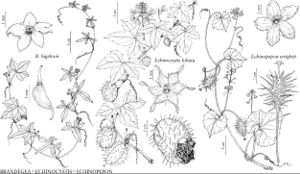Brandegea
Proc. Calif. Acad. Sci., ser. 2, 3: 58. 1890.
| Taxon | Illustrator ⠉ | |
|---|---|---|
 | Brandegea bigelovii Echinocystis lobata Echinopepon wrightii | Yevonn Wilson-Ramsey Yevonn Wilson-Ramsey Yevonn Wilson-Ramsey |
Plants annual (sometimes short-lived perennial), monoecious, sprawling, trailing, or climbing; stems annual, glabrate; taprooted or roots slender-fibrous; tendrils unbranched. Leaves: blade hastate, 4–5-angular, or suborbiculate, shallowly to deeply palmately 3 (–5) -lobed, lobes triangular or ovate to linear-oblong, central lobe usually longest, margins entire, surfaces eglandular. Inflorescences: staminate flowers (1–) 2 (–3) in axillary racemes or racemoid panicles; pistillate flowers solitary in same axils as staminate, irregularly produced; peduncles erect at apex; bracts absent. Flowers: hypanthium cupulate; sepals 5, barely differentiated as apiculae; petals 5, distinct or nearly so, white, triangular to ovate or narrowly oblong-triangular with acute apices, 1–1.5 [–3] mm, glabrous, corolla rotate to shallowly cupulate. Staminate flowers: stamens 3–5 (appearing 1–3 from connation); filaments inserted at hypanthium base, connate; thecae connate, forming a head but not fused into ring, horseshoe-shaped, twisted-contorted, connective broad; pistillodes absent. Pistillate flowers: ovary 1-locular, broadly fusiform-rostrate; ovules 1 (–2) per locule; styles 1–3, columnar; stigmas 1, depressed-globose to hemispheric, sometimes 2-lobed; staminodes absent. Fruits capsular, light tan, obovoid to suborbicular, gibbous, slightly compressed, beaked, dry, thin-walled, sparsely short-echinate or subaculeate, spinules thick-based, antrorsely upturned, irregularly dehiscent. Seeds 1 (–2), subcylindric-clavate to obdeltoid, compressed, not arillate, margins not differentiated, surface muriculate to warty.
Distribution
sw United States, nw Mexico
Discussion
Species 1.
J. N. Rose (1897b) recognized five species of Brandegea (without a key to distinguish them). Of the five, B. minima (S. Watson) Rose was later transferred to Cyclanthera (D. M. Kearns and E. C. Jones 1992); the others have been relegated to synonymy of B. bigelovii.
Selected References
None.